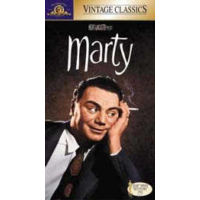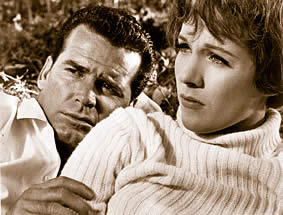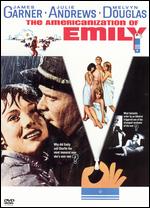Who is the blogger?
archived entry
Marty (1955) and The Americanization of Emily (1964)
Everyday Heroes
An independent film about a working class stiff who navigates dangerous social waters to find love and happiness. Marty is sure a nice fellow and this is sure a nice film to watch again and again.
I saw Marty again on TVO's Saturday Night at the Movies. I liked it just as much as I did the first time I saw it many years ago. Ernest Bornine, in his Oscar-winning title role as Marty is such an affable fellow after all.
Before I sat down to watch the film I wondered if it would be as good as I remembered it being. I was not disappointed.
The characters and character development was warm and real even if most of the people in the movie were sort of stereotyped: the Italian mama (Esther Minciotti as Mrs. Piletti), the tiresome mother-in-law (Augusta Ciolli as Aunt Catherine), the quarrelsome couple striving for independence and self-definition (Karen Steele and Jerry Parris as Virginia and Tommy), the “good time Charlie” (Frank Sutton as Ralph) and the perpetually immature and self-absorbed drinking buddy (Joe Mantell as Angie).
 Marty himself is such a plain talking fellow and Ernest Bognine is such a wonderful actor in this role that you connect with him right off the bat. In the opening scenes Marty is lectured by well-meaning but totally insensitive female customers in the butcher shop. The stinging speeches about not yet being married as well as Marty’s mute reaction to them set the tone for the rest of the film. I noticed much more this time around the structure of the film, how various lines were reframed and purposely repeated by Paddy Chayefsky, the screenplay writer, in order to move the action forward. An example of this would be where in the closing scene of the film instead of listening acquiescently to his customers’ nauseating harping about his singlehood (“You oughta be ashamed of yourself!”), Marty energetically repeats the same line from the opening scene to his friend, Angie, as he slams shut the door of the phone booth and calls up Clara in order to ask her out on another date. Self-determination wins the day. I noticed much more on this viewing the “stage play feel” of the film.
Marty himself is such a plain talking fellow and Ernest Bognine is such a wonderful actor in this role that you connect with him right off the bat. In the opening scenes Marty is lectured by well-meaning but totally insensitive female customers in the butcher shop. The stinging speeches about not yet being married as well as Marty’s mute reaction to them set the tone for the rest of the film. I noticed much more this time around the structure of the film, how various lines were reframed and purposely repeated by Paddy Chayefsky, the screenplay writer, in order to move the action forward. An example of this would be where in the closing scene of the film instead of listening acquiescently to his customers’ nauseating harping about his singlehood (“You oughta be ashamed of yourself!”), Marty energetically repeats the same line from the opening scene to his friend, Angie, as he slams shut the door of the phone booth and calls up Clara in order to ask her out on another date. Self-determination wins the day. I noticed much more on this viewing the “stage play feel” of the film.
Even though Marty is very well anchored in a particular place, in a particular time, it seems to me that one of the reasons why the film remains so charming is that there is an “Everyman” kind of quality about the character of Marty. He is such an ordinary guy. He is so Italian Catholic. He is so post-World War II American. Scenes of the family preparing for mass are as unaffected and spontaneous as Marty’s “out of the blue” query to Clara after their rambling late night conversation: “Are you Catholic?” It was important, let’s say foundational, for Marty to assure himself that he and Clara shared a value system and a perspective on life encompassed by that question. It was just a totally normal thing for Marty to ask in his day and age.
Such a question today would be jolting if not revolting for a modern film audience. At best one could try to pull it off as a joke. But Marty is perfectly serious, perfectly honest, perfectly natural, just as he is in the rest of the film. My, but times have changed.
On the other hand, one can observe that some things have changed for the better. It is jolting and revolting to me to see and hear the language used in the film to describe women. There is what becomes a comical line in the mouth of the Mrs. Piletti, when the Stardust Ballroom is described as being “loaded with tomatoes”. Women are objectified in a way that was so typical and socially acceptable at that time. Clara’s “blind date” at the Stardust Ballroom is seen abusing a cigarette machine. He is incensed over the fact that he “expected something better than the dog he got” because after all he only got one Saturday night off every two weeks. He expected his money’s worth from Clara just like he expected his money’s worth from the cigarette machine. I am afraid that the general standard of the day was that this guy was justified in treating both the girl that he liked and the one he wanted to ditch no better than the malfunctioning cigarette machine, just because he “paid for something”.
Mickey Spillane “sure knows how to handle women” in his crime novels according to the bachelors’ worldly wisdom freely offered to our hero. Fortunately, Marty turns his gaze from such a “lofty model” on how to handle women and remembers a more humble, a more real and a more tender prototype for social behaviour: the interaction between his own mother and father. Marty treats Clara differently than the other men in the room because Marty is different. Marty starts the dialogue between the sexes by valuing Clara for who she is as a person, not for what she can give him. As a bonus, Clara’s interaction with him makes Marty feel wonderful about himself and about life.
Although Clara does show signs of being a liberated modern Miss, (she has completed university, earns her own living and thinks that Mama should not be so entirely dependent upon her children for her happiness) you don’t get the picture that the fundamental respect that Marty shows her is based upon lately learned lessons from the Women’s Liberation Movement. It goes back farther than that. It goes back to seeing his mama and his papa treat each other with old fashioned tenderness and respect throughout a lifetime in the everyday moments around the Piletti home.
Although this film has a definite sense of time and place, it wears well because it keeps timeless values in the forefront.

And as for “The Americanization of Emily” – well, you go from a couple of people who are not particularly beautiful on the outside but have something going for them on the inside (Marty and Clara) to two people who have great “movie star looks” but are more than a little bit messed up on the inside (Lt. Comdr. Charlie Madison and Emily Barham)
Whereas I would characterize Marty as a surprisingly good film, my experience of watching The Americanization of Emily was a sense of being off kilter somehow. There are some surprises woven into the action of the plot, to be sure, but that does not really account for my sense of being off-balance. Ridiculous twists and turns in plot evolution are entirely acceptable and expected in such comic films.
There is the fact that it is a 1960’s film in black and white. That is somewhat fitting as the film is about propaganda generated in endless black and white newsreels during the Second World War. Perhaps the choice of black and white adds to the fact that the genre of the film has been described as a black satire. Still, you kind of expect to see Julie Andrews and James Garner and others of their generation filmed in glorious technicolour.
There is the fact that this is an anti-war movie filmed at the beginning of Vietnam and yet it chooses as its subject matter a very popular war, WWII. You feel like some of the tone and vehemence of the central speeches of the film are more compatible with what was going on during the Vietnam War rather than with World War II. Is this just a projection back in time of a sentiment that was not really prevalent in the society of the day? Surely during WWII there were craven cowards and self-serving stewards such as the “dog-robber” Charlie Madison, just as there have been in all wars. But it seems to me that a film such as this one could only have been made 20 years after that war. I don’t think that the American public would have accepted such a stark evaluation of things at the time of the war or that Hollywood would have dared to say such things about that war. Somehow there seems to be something inauthentic about going back and saying it after the fact.
 It is not that I don’t think that the content of the anti-war speeches of Paddy Chayefsky in this film are not legitimate, brilliant, and at times stunningly funny. They are great speeches. The scene where Madison unceremoniously dismantles Mrs. Barham’s delusions about life and the war is wonderful. It is just that I don’t quite think that it works for the speeches to be in the mouths of the characters. The characters aren’t real people anymore – their lives and their actions in the film become an excuse to voice anti-war rhetoric.
It is not that I don’t think that the content of the anti-war speeches of Paddy Chayefsky in this film are not legitimate, brilliant, and at times stunningly funny. They are great speeches. The scene where Madison unceremoniously dismantles Mrs. Barham’s delusions about life and the war is wonderful. It is just that I don’t quite think that it works for the speeches to be in the mouths of the characters. The characters aren’t real people anymore – their lives and their actions in the film become an excuse to voice anti-war rhetoric.
But perhaps that is how it is all how it is supposed to be. The film catches you off-balance. It gives you something that you don’t quite expect and doesn’t give you what you have come to expect. Yes, I think that I can say that it is an interesting film.
It is interesting for very different reasons than Marty. While Marty has something worthwhile to say about the human condition and therefore will remain somewhat timeless in its relevance, I think that the interest factor in The Americanization of Emily may be different as time goes by. Perhaps people will say, “Here is an interesting piece about how attitudes about war changed in America between the end of WWII and the beginning of Vietnam .”
Both films are worth watching, but I think to be honest I am more likely to be in the mood to watch Marty again than The Americanization of Emily.
Suggested Reading:
- "I love a man with great ears on him" - The winsomeness of good communication skills
- Runaway Bride - Are you really up for it when it comes to getting married?
- Let's take it from the top. Who's directing your life?



